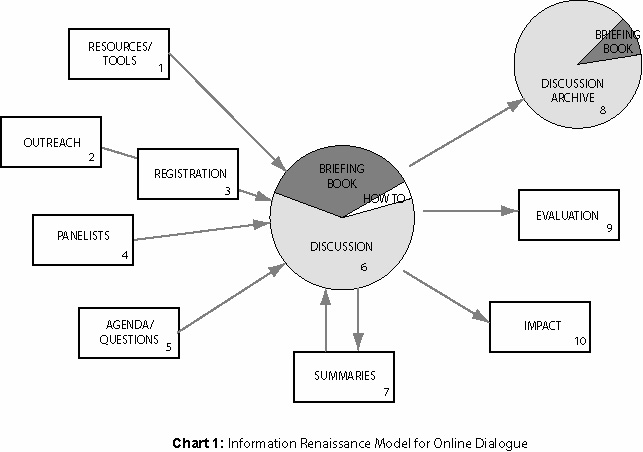Background
Information Renaissance Model for Online Dialogues
Information Renaissance dialogues provide informed public comments for organizations, government agencies or elected officials. We bring together members of the public to learn about a complex issue and discuss it with subject experts, public advocates, and policy makers.
Our online dialogues are open to the public. Participants are requested to register, but anyone can read the discussions and daily summaries, and review background resources. Participants join in at their convenience (unlike a chat room, for which all must be online at the same time); they can take time to reflect on background materials and others' postings, and reply at any time of the day or night. The dialogue Web site is maintained as an archive long after the online discussion has concluded, providing an authoritative information and reference. As an example, please visit the dialogue archive on the
California
Master Plan for Education
or the national dialogue on
Public
Involvement in Environmental Protection Agency Decisions.
An archive of additional dialogues and related resources is located in the
What We Do
section of this Web site.
Careful preparation is the key to a successful online dialogue. Below is an outline of components that have typically been used in Information Renaissance events; numbers refer to Chart 1, which illustrates the relationship among these components.

- Resources & Tools. For each dialogue, a searchable Web site is developed, each with its own recognizable character. Information Renaissance works with collaborating organizations to provide a "Briefing Book" of thought-provoking online background material. Participants are urged to become familiar with this material before the dialogue begins. A "How To" section gives information on both online dialogue and use of the site. We work to make our presentations accessible in terms of both content and technology, including Section 508 compliance.
- Outreach. We believe a successful dialogue requires the identification and involvement of key stakeholder groups. The dialogue is announced through electronic mailing lists, Web sites of organizations, press releases and newsletters, and media coverage is sought. Key stakeholder groups help in this effort. Encouraging participation from a demographically broad group of dialogue participants, including traditionally underserved communities, requires extensive and focused outreach.
- Registration. Participants register to take part, providing some basic identifying information, such as name and e-mail address. More extensive demographic information may be collected to aid in evaluation.
- Panelists. Panels of subject experts, members of advocacy groups, and policy makers are recruited to be a part of the online dialogue. They are not asked to give "speeches" but to interact with public participants, answering questions and exchanging ideas. Online panels or a roundtable discussion among experts are sometimes used to invite input on specific issues, explore complex issues or help indicate areas of possible consensus.
- Agenda & Questions. The public discussion is structured around a series of issues, with specific questions used to maintain focus. Participants are urged to use the message "threads," which make it possible to read the messages in order of topics.
- Discussion. An online dialogue takes place over two or more weeks. The dialogue is asynchronous: participants can take part at their convenience, with ample time to reflect on background materials and the postings of other participants. The dialogue is moderated to help keep the conversation focused and to deal with the rare cases in which the discussion becomes too heated, although in our experience a properly structured event is typically very civil. Moderators also present discussion questions, give tips and are available for questions.
- Summaries. Daily discussion summaries provide an overview of what has transpired, enable participants to remain current even if they don't have time to read all comments, and help newcomers join the discussion. These are much appreciated by participants.
- Archive. The Web site is maintained as a searchable online archive after the conclusion of the interactive activity. This includes the entire site -- the Briefing Book, messages contributed to the dialogue, discussion summaries and so forth.
- Evaluation. Until this procedure becomes routine, our preference is to evaluate each dialogue in terms of how well it meets the needs and expectations of public participants and the sponsoring organization.
- Impact. Although these are difficult to quantify, the outcome of a dialogue can be seen in terms of various types of impact. One type asks if public involvement has made a difference, in terms of public input, legislation or other decision-making. Another relates to participants in the dialogue: has the activity changed their outlook, for example their interest in government or their understanding of other stakeholders?
|

